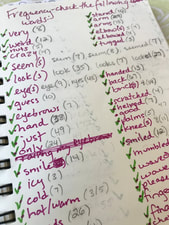 By Annie Cronin Romano If you’ve ever taken a workshop on novel revision, there’s a good chance you’ve heard your fellow writers mention doing frequency checks on words that are often overused. These “weed words” are words or phrases that pop up over and over in your manuscript without adding texture to your narrative. Using the “find” feature, you type in the word you want to check and then edit accordingly. But did you know the exercise of a frequency check can and should go beyond merely deleting or changing an overused word? It can help you catch stereotyped phrasing and increase your awareness of varying descriptions and vocabulary. Recently, I was completing frequency word checks while editing my middle grade novel. When I first started the revisions, I kept a running log of words I noticed I was using frequently. Rather than interrupt my flow when writing, I'd simply jot down the word in my log to check later. However, it was while doing the common words frequency check that I discovered my own personal “weed words.” For instance, I never realized how frequently I used the words “hand” "reached," and “turned” in this particular manuscript until I started the frequency check. They kept showing up! I was astounded at how often I used certain words I didn’t think of as overly-common. In finding those words, I also picked up on similarities in many of my descriptions. (Didn't she "roll her eyes" three paragraphs ago?) As I edited, my weed word list grew from about 40 words on my running list to over 100 words (i.e., adding "roll" and "eyes"), and the task at hand became much more than a find-and-replace drill. I delved deeper into my writing, examining my voice and style as I edited. Questions I began asking included, “How can I convey that feeling differently?” "Is this truly how the character would say this?" “What else can my character do to show that reaction?” and “Is this line essential/moving the story forward?” What started as a basic editing drill led me to reexamine my overall writing technique and how it impacted my story as a whole. The result was a significantly stronger manuscript. I have included a frequency words list below, which includes words I discovered I use too often (my own personal "weed words") as well as some of the usual suspects ("very," "really," "seems," etc.). Your list may look quite different, but this will give you a place to start. Sometimes your weed words may be project-specific (i.e., if you're working on a book that takes place in the desert, check for words like "sand," "dry," and "arid"). You don't have to eliminate every instance of these words; use the list as a tool to ensure you vary your vocabulary and minimize common phrasing and descriptions. The next time you’re editing your work, consider going beyond the find-and-replace approach to thinning out your weed words, and dig down further to bring out the best in every line. Weeding, when paired with conscientious revision, will make every word sing!
0 Comments
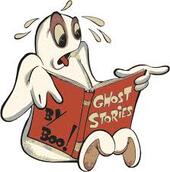 By Annie Cronin Romano October is well under way with leaves of amber and crimson, cool, crisp evenings, apple cider, winding corn mazes, and, of course, Halloween! Whether it’s carving pumpkins or choosing what costume to wear trick or treating, most families have traditions they enjoy throughout the fall season. As you embrace Halloween preparations, don’t forget to visit your library or bookstore to snag a few Halloween and seasonal books, and add some new favorite reads to your October rituals. This list contains just a sampling of the entertaining spooky and autumn-themed kidlit books to be discovered. Included are both older classics and newer releases. Most I have read and enjoyed myself. A few were suggested by other avid readers. Pick one or all of them, and dive into these stories of pumpkins, scarecrows, and things that go “Boo!” in the night! PICTURE BOOKS MR. PUMPKIN’S TEA PARTY by Erin Barker ROOM ON THE BROOM by Julia Donaldson, Illustrated by Axel Scheffler THE SCARECROW by Beth Ferry, Illustrated by the Fan Brothers LOS GATOS BLACK ON HALLOWEEN! by Marisa Montes, Illustrated by Yuyi Morales SAMURAI SCARECROW: A VERY NINJA HALLOWEEN by Rubin Pingk OAK LEAF by John Sandford BIG PUMPKIN by Erica Silverman, Illustrated by S.D. Schindler THE LITTLE OLD LADY WHO WAS NOT AFRAID OF ANYTHING by Linda Williams, illustrated by Megan Lloyd MIDDLE GRADE THE NIGHT GARDENER by Jonathan Auxier THE JUMBIES by Tracey Baptiste WATCH HOLLOW by Gregory Funaro THE GRAVEYARD BOOK by Neil Gaiman TOOK: A GHOST STORY by Mary Downing Hahn SCARY STORIES FOR YOUNG FOXES by Christian McKay Heidicker GHOST: THIRTEEN HAUNTING TALES TO TELL, a collection by Illustratus And a few YOUNG ADULT… MARY’S MONSTER: LOVE, MADNESS, AND HOW MARY SHELLEY CREATED FRANKENSTEIN by Lita Judge MISS PEREGRINE’S HOME FOR PECULIAR CHILDREN by Ransom Riggs PUMPKIN HEADS: A GRAPHIC NOVEL by Rainbow Rowell, Illustrated by Faith Erin Hicks Please share some of your favorite kidlit Halloween/fall season books in the comments.
And HAPPY HALLOWEEN! ~ by Amanda Smith 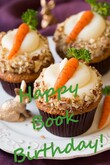 24 Carrot Writing celebrates with Kristine Asselin as her new Young Adult novel, Falling for Wonder Boy hits shelves today! When sixteen-year-old Kate Anderson signs up for the New Hampshire Junior State Golf Championship, she has no idea how important it is for her to win. But when she finds out her family’s beloved golf course is on the verge of going broke, the pressure is on to bring home the top prize. If she can become the first girl to ever win the tournament, she’ll earn more than bragging rights and a college scholarship – she’ll become famous. And with fame comes a gigantic media blitz, and that type of hype is exactly the prize her family needs to bring back the crowds and chase away the threats of bank foreclosure. Unfortunately, golf is a game of focus and Kate’s distractions are mounting by the day: her growing crush on her best friend Scott and dealing with the local bully seem tough enough without the extra distraction of the cute British exchange kid her dad hires for the summer. But when vandals damage the golf course and Scott is accused of the crime, the stakes suddenly become bigger than any tournament. To clear Scott’s name, Kate takes on the responsibility of finding the culprit before the course is vandalized again. Otherwise, winning the tournament won’t even be on the table, and neither will a future with Scott. Kristine shares the inspiration behind the novel, as well as her path to publishing: Falling for Wonder Boy has truly been a labor of love for me. When I started writing in 2006, I was drafting mostly picture book texts for my toddler—they were okay, but not great. I got some nice feedback, but nothing more. When a friend reminded me of an anecdote from our teen years, I had an epiphany. It would make a great YA short story. My parents managed a golf course in the 1980s. They bought it when I was in the 6th grade. For my entire teen years, we lived, worked, and played golf. When I was in high school, I was the only girl in my four years to go out for the golf team. It just wasn’t a sport girls played in my world. After I wrote the short story, I shared it with a few trusted friends. And the overwhelming response was that people needed to know more about the characters. That short story ended up being published in Golfer Girl Magazine in 2008 as “The Knight in Tan Khakis” and is more or less Chapters 9 and 10 in the book—where Scott tosses Kate a sweatshirt to cover up a see-through wet t-shirt. Since 2008, that short story has evolved. For a long time, the title of the novel was The Sweet Spot. It’s been through a dozen revisions, it landed me my agent (more than once). It was acquired by a publishing company and then rejected after the decision was made that golf wasn’t something that would sell to teens. I’ve written other things, including a ton of nonfiction and two published novels (Any Way You Slice It and co-written The Art of the Swap). In fact, Any Way You Slice It was a direct result of that failed acquisition. The Sweet Spot was shelved for years, but in late 2018, after ten years of close calls, I decided to work with K.R. Conway at Wicked Whale Publishing to independently publish the book. I changed the title to Falling for Wonder Boy and I haven’t looked back. I’ll be honest, in some ways it’s scarier than anything else I’ve ever published. There are pieces of my heart on display for all to see—it’s mostly fictionalized, but there are moments that really happened (like the sweatshirt toss). Emotions that were real. This book is truly the book of my heart. Not only is it firmly grounded in my own history, it’s also been the backbone of my writing career. Working on this book taught me how to write. It opened doors for me professionally. It deserves to be out in the world. I’m grateful to K.R. Conway for her support, guidance, and amazing design skills. I could not have imagined a better skin for Kate and Scott to live inside. I’d love to engage with readers. Please let me know what you think!  Bio Kristine is the author of sixteen works of children’s nonfiction as well as the YA novel Any Way You Slice It and co-author of the middle grade novel The Art of the Swap. She loves being a Girl Scout leader and a Library Trustee, and volunteering with the Society of Children’s Book Writers and Illustrators. Her alter-ego is The Query Godmother and she loves critiquing queries and helping people with submission packages. She lives on the outskirts of Boston with her teen daughter and husband, and is represented by Kathleen Rushall of the Andrea Brown Literary Agency. Visit her at www.kristineasselin.com/ And a give-away!
One lucky reader can win a copy of one of Kristine's YA novels, Any Way You Slice It or Falling for Wonder Boy. A second reader can win a copy of The Art of the Swap, the MG novel Kristine co-wrote with Jen Malone. (Click here for a review.) Leave us a comment. Winners will be announced March 1, 2019. 24 Carrot Writing is pleased to host Andrew Jenrich, Director of the Taft Public Library in Mendon, MA. All four of us have benefited from Andrew's comprehensive knowledge of the publishing industry, as well as his ability to place "just the right book" into our hands (as well as the many library patrons' hands!). We hope you'll find his perspective on what he's acquiring, and what he hopes to acquire in the future, helpful in your writing process. 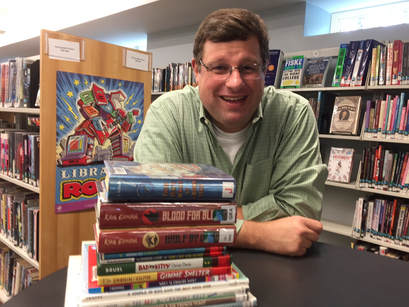 Guest Post by Andrew Jenrich As Director at the Taft Public Library one of the most rewarding tasks I have is developing the library’s book collection for children and young adults. That’s not to say it isn’t a daunting job, especially since so many new titles release weekly. If there is any frustration in the collection development work I do, it stems from the nagging feeling that I’ll forever be chasing the publishing game and will never quite catch up. We are a smaller library and, since the shelf space in our library is limited, I realized long ago that I would need to be particularly selective about what winds up on our shelves. So, what determines the choices I ultimately make for our library? What catches my eye and peaks my interest enough to convince me to part with the library’s dollar? Those are interesting questions. I do know the criteria I use for evaluating a board book vs. a chapter book vs. upper-level juvenile fiction for purchase are different. There is no one method I employ. And there probably shouldn’t be. Audiences for each format vary and publishers have become very savvy about what appeals to different age groups. The challenge for me is in anticipating what our patrons will want of what does get published. Some of the selection process is straightforward – series books for characters like Fancy Nancy, Pinkalicious, Pete the Cat, and Dog Man always circulate and they, along with series like Wimpy Kid, I Survived, and Spirit Animals take up a fair bit of space on the shelves. Add in books by renowned authors – your Rick Riordans, Mo Willemses, J.K. Rowlings, and Kate DiCamillos – and that’s a significant portion of the collection. But having those titles does not mean every interest of our library patrons has been met. There is still plenty of room for diversifying, for growing the collection beyond the core popular titles. Below is a synopsis of what I look for when selecting titles for the Children’s and Young Adult collections at our library. I’ve broken it down roughly by age group and, within each entry, I’ve tried to highlight some of the current trends I’m seeing and, where possible, pointed out the genres, subject matter, and storylines that seem too prevalent in some of these categories. 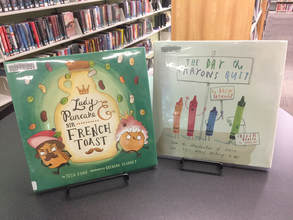 Board Books and Picture Books I’m a fairly visual person so I admit that the first thing that draws me to a board or picture book are the illustrations. They don’t need to be a certain style. In fact the good news in publishing for the very young is that there are many styles illustrators can employ that work effectively. Sure there’s a bit of mimicry here and there, but there are plenty of illustrators whose style is unique and distinct. So, yes, I’m drawn to the illustrations. That said, there’s nothing more disappointing than a picture book which delivers on the illustrations but is weak on storyline and content. The words do matter. When I was a Children’s Librarian and hosted storytimes I have to say I gravitated to titles with less text (kids can only sit still for so long). The books I liked most in those situations were the ones that “brought the silly.” Mo Willems, Jules Feiffer, Jon Agee, and Jan Thomas were always a hit. If a book could bring the silly and convey a lesson, well, all the better. Some books with more text did work during storytimes (Tomie DePaolo’s Strega Nona and Michelle Knudsen’s Library Lion worked far better than I imagined, Marla Frazee’s books were great too), but those instances were rare. What have I seen too much of in storybooks the last few years? Dragons, dinosaurs, princesses, penguins, mice, and bears. Don’t get me wrong, we still purchase titles with all of the above precisely because they circulate, but there’s entirely too much of it. And I do like anthropomorphism (Valeri Gorbachev and Peter Brown’s humanized animals are favorites of mine), but give me characters, animal or otherwise, I don’t normally see. Give me Lady Pancake, Sir French Toast, and Crayons that quit. I’ll likely take notice. Easy Readers and Early Chapter Books Some authors like Jan Thomas and Mo Willems have successfully moved into easy reader territory and we carry their titles. What’s nice is they continue to do work that isn’t text-heavy. I’ve found that text-heavy easy readers have a very limited appeal. If a child is looking for more text often they just move up to early chapter books like Nick Bruel’s Bad Kitty series or Doreen Cronin’s Chicken Squad books. Illustrations still matter in easy readers and early chapter books. In fact more and more books from both these categories seem to be taking a cue from graphic novels incorporating full page panel layouts, word and thought bubbles and other comic book devices. Scholastics’ line of early chapter books called Branches does this very well. They’re intended as a bridge between leveled readers and regular chapter books. Kung Pow Chicken, Monkey and Me, and Owl Diaries are all Branches titles that kids gravitate to here at the library. There’s plenty of text, it’s just that it’s often presented in comic book format with splashy engaging illustrations. What would I like to see more of in easy readers and early chapter books? I’d like to see more nonfiction easy readers and rebus readers where pictures occasionally take the place of common nouns throughout the story. Based on patron requests there’s a demand for both. I’d also like to see early chapter books with a bit more heft and content to them. The great thing about series like J.C Greenburg’s Andrew Lost or Osborne’s Magic Tree House is that you learn something in the process. Juvenile Fiction With Wimpy Kid, Big Nate, and the Dork Diaries series you’re seeing hand-drawn diary and graphic novel techniques infiltrating juvenile (chapter book) fiction too. It’s clear publishers think kid culture is much more visual now and, based on readership of those series and others, it’s hard to argue they’re not right. We purchase all of the above and countless other series. Realistic fiction titles (school stories, family stories) seem to be on the increase due to the popularity of the Wimpy Kid and Dork Diaries books. Most juvenile fiction series (and, believe me, publishers are obsessed with making everything into a series now) fall into the fantasy and adventure categories though. I loved the Harry Potter series but so many publishers started to roll out fantasy series during and after Harry hoping to “catch lightning in a bottle” that the result was a fair bit of forgettable fiction, though authors like Rick Riordan, Brandon Mull, and Pseudonymous Bosch capitalized. Bosch’s Secret series and Mull’s Fablehaven books are both very worthy and most everyone knows what a hit Percy Jackson has been with younger readers. What’s lacking in juvenile fiction? I don’t think there are enough mystery and compelling historical fiction titles written for preteens. Every so often a series like I Survived stokes the imagination of young readers, but it doesn’t happen enough. More sports novels for girls would be helpful too. Mike Lupica, Tim Green, and John Feinstein write excellent sports novels, but they feature boy protagonists in male-dominated sports. 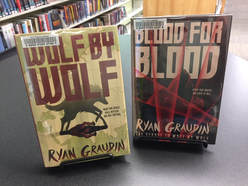 Young Adult Fiction In my twelve years at the library no one area has grown so much as young adult fiction. The number of titles has grown and the category itself has matured. I think YA fiction suffered under the assumption that much of it was bleak and focused on hyper-dysfunctional families and relationships. There is a percentage of it that still does (and dysfunction provides drama), but I see authors taking more chances with genre now. Yes, YA literature had its vampire and werewolf phase (thanks Twilight) and it still clings desperately to its Hunger Games-inspired dystopias. Veronica Roth’s Divergent series, Alexandra Bracken’s The Darkest Minds, and Neal Shusterman’s Arc of the Scythe series all mine this territory and do it fairly well. But I like when an author takes an even bigger chance like Ryan Graudin does in Wolf by Wolf and its sequel Blood for Blood, novels that take place in Nazi Germany and feature a girl protagonist who is also a shape-shifter intent on assassinating Hitler. It sounds like a lot to swallow, and it is, but Graudin pulls it off beautifully. If an author is going to imagine an alternate world I like it when they go all in. Thankfully more of that is happening. There is still plenty of room, of course, for realistic and topical teen fiction. I’ve been happy to see more teen mystery and suspense titles recently and it’s nice when historical fiction series like Laurie Halse Anderson Seeds of America books receive recognition and a devoted readership. I’ve also been particularly pleased that recent multicultural titles like Angie Thomas’s The Hate U Give and Tomi Adeyemi’s Children of Blood and Bone have found a wider audience. In truth there is so much good stuff out there now for children and teens to enjoy. Some of the best work being done right now across the juvenile and teen book landscape is in graphic novels. Shaun Tan, Gene Luen Yang, Raina Telgemeier, Noelle Stevenson – I could go on ad nauseum about the brilliant work they’re doing. Perhaps another time. Right now I have orders to place, so if I could kindly ask that publishers sit back and take a short break? I really need to catch up! The Taft Public Library is located at 29 North Avenue in Mendon, MA.
|
Peruse blogs for advice and tips from KidLit creatives.
Categories
All
Archives
April 2024
Click to set custom HTML
Click on the RSS Feed button above to receive notifications of new posts on this blog.
|
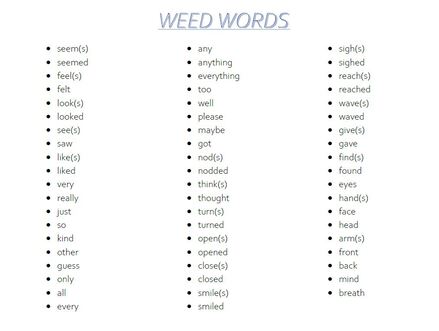
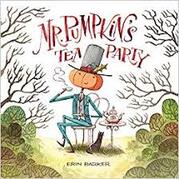
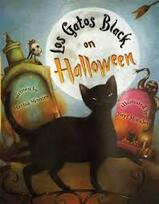
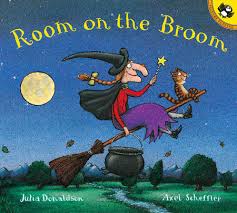
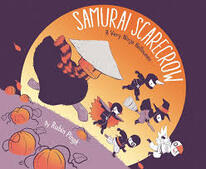
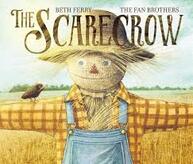
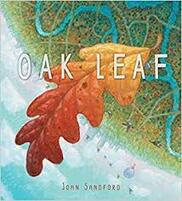
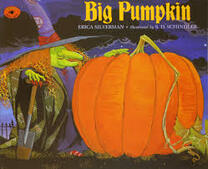
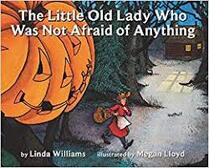
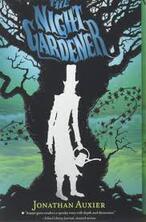
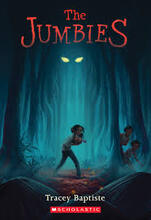
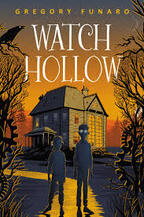
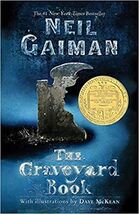
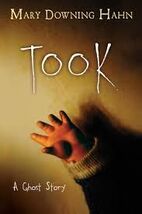
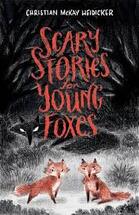
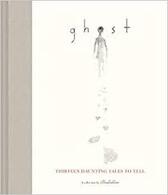
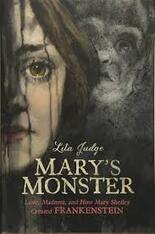

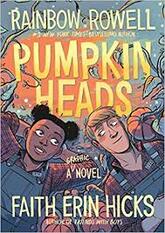

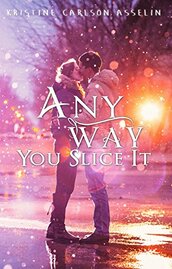
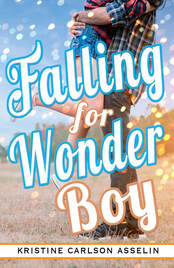
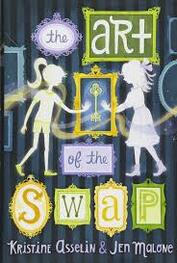

 RSS Feed
RSS Feed